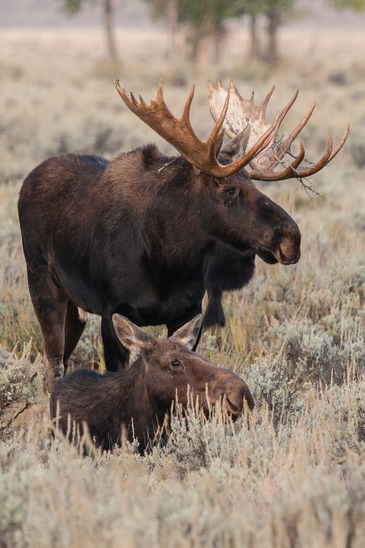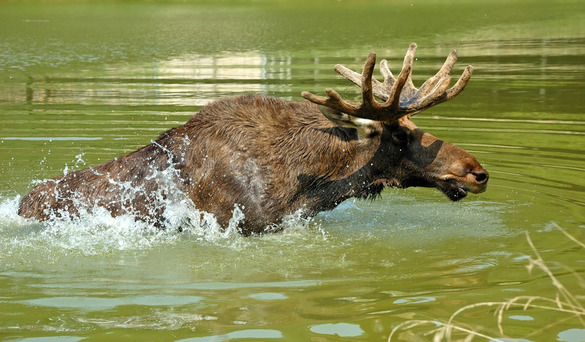A Way of Life in the USA
Hunting is a way of life in the United States, and we are here to help you be as successful on the hunt as possible.
The Best States to go Moose Hunting
 The moose is the largest game animal in the United States, and as management practices have allowed the population to grow, hunting moose has become an increasingly popular challenge.
The moose is the largest game animal in the United States, and as management practices have allowed the population to grow, hunting moose has become an increasingly popular challenge.
Whether you want the biggest bull you can find for a trophy or would be just as happy with the meat from a cow to stock your freezer, you need to know where to go to have the best chance of a successful hunt.
Alaska is by far the best state for moose hunting. Second place belongs to Maine, and after that you might look at Idaho and Washington. Moose hunting is expensive wherever you go, costing thousands of dollars and sometimes exceeding $20,000. Permission to hunt moose is usually alloted through a drawing. Applications must be made months in advance, and it may take years before you win a chance to hunt.
Although most people use the services of guides, it is ultimately your responsibility to make sure your paperwork is in order and your hunt is legal. Visit the website of the state in which you will be hunting and read the rules and regulations. You do not want an expensive trip to be made even more costly by fines, and you do not want to have your kill confiscated or yourself arrested because the hunt was illegal.
Alaska
Alaska is, without a doubt, the most appealing choice for the hunter looking for that once-in-a-lifetime trophy moose. The moose in Alaska are of the Alaska-Yukon variety, which is the subspecies with the largest animals. The bulls can reach weights of 1800 pounds and have a spread of 65 inches.
Moose are widely distributed throughout the state. Since much of the land is owned by the state or federal government, most hunting takes place on public lands. Private land is most often under the control of corporations owned by native populations, although there are also some plots owned by individuals near the more populated areas.
If you are using the services of a guide, the guide company will probably have a territory in which it operates and will know that this area is a legal public hunting ground. It is, however, your duty to ensure that your hunt is legal. When you are making plans, it is a good idea to check the maps on the Alaska Department of Fish and Game website to see where your guide will be taking you and confirm that it is permissible for you to hunt there.
If you are not planning to use a guide, there is one more thing to be aware of when you choose a location: Some public lands are only open to residents who live in rural areas. Check with the state authorities, and then check again, to make sure you are hunting in an area where it is legal for you to do so.
Since moose can be found throughout Alaska, the terrain that you will be navigating during your hunt can vary, but it will almost always be rough. During the fall hunting season, the oldest, biggest bulls will be the first to move out of their summer ranges and into the higher elevations. They will be found in heavily forested areas with thick underbrush. You may have to climb hills or slog through the sloppy ground that surrounds the streams and lakes that attract moose.
Moose hunts in Alaska usually require a plane ride to your camp. If you are not hunting in the immediate area of the camp, you will need horses or motorized vehicles available to haul out your kill. A large moose can yield up to 700 pounds of meat, which is not manageable for a person on foot over a long distance.
If you are up for a challenging hunt in a remote, rugged space and are looking for a chance at one of the largest bulls in the United States, Alaska may be the place for you.
Maine
Northern Maine is the best choice for hunters who find that either the cost or the distance of a trip to Alaska puts that option out of reach. Maine has the most dense concentration of moose in the lower 48 states.
The subspecies of moose found in Maine is the Eastern variety. The bulls can top out at weights over 1000 pounds and have a spread from 38 to 50 inches, although trophies with spreads up to 57 inches have been recorded. The success rate of Maine hunters is also encouraging; while the overall rate is about 70 percent, an experienced guide can push that to 95 percent.
Permits to hunt moose are issued by the Maine Department of Inland Fisheries and Wildlife and are valid for specific locations. The most desired area, especially for hunters coming in from out of state for a guided hunt, is the region known as the North Maine Woods. This is land that is privately owned by large lumber and paper industries.
The managed forests of the North Maine Woods offer excellent habitat for moose, which has helped to increase their population. Incidentally, the management practices also offer advantages to hunters. The land is served by logging roads that give hunters easier access to the interior, and cutting practices make the forests more open with greater visibility.
The terrain in the North Woods ranges from rolling hills to lowland swamps. Much of it is covered with hardwood forests, but they are interspersed with stands of softwood and cedar.
Almost all the land in Maine outside the North Maine Woods is also privately owned. Some areas are controlled by Native American tribes, and they have sole authority to regulate hunting activities. If you use a guide service, they should take the lead to make sure you have permission to hunt on private land, but it is ultimately your job to obey the rules.
Idaho
 There are several Western states that support moose populations, and Idaho is particularly attractive for hunters. The moose in Idaho are of the Shiras subspecies. They are the smallest variety of moose, with the bulls ranging from 850 to 1100 pounds with spreads that average about 45 inches.
There are several Western states that support moose populations, and Idaho is particularly attractive for hunters. The moose in Idaho are of the Shiras subspecies. They are the smallest variety of moose, with the bulls ranging from 850 to 1100 pounds with spreads that average about 45 inches.
Although moose hunting is popular in Idaho, the animals seem to respond well to hunting pressure here and their numbers remain strong. Moose can be found throughout the state, but the area closest to the Canadian border has the greatest density. Hunting success rates in Idaho approach 100 percent, and many of the animals are true trophy quality.
The moose in Idaho are found in varied terrain. At higher elevations the ground will be more rugged, while the river valleys are more accessible and easier to navigate. Moose even make themselves at home on agricultural and range land. With large swaths of the state available for hunting, and moose that have adapted to almost every habitat, finding the environment that best suits your preferences and abilities is not difficult.
Hunting land in Idaho may be publicly or privately held. It is best to check the maps at the Idaho Department of Fish and Game to see where your permit allows you to hunt, and always make sure you have permission from private landowners to hunt on their land or pass through it. Do not assume that public lands, such as parks and wildlife preserves, allow hunting, as some do and some do not.
Washington
Washington state is another tempting destination for moose hunting. The number of the animals in Washington seems to be increasing at an impressive pace, making it a viable choice now and into the future.
The highest concentration of moose is found in the northeast part of the state. The land available for hunting is a mix of private and public, with some areas controlled by the US Forest Service and some belonging to logging interests or private citizens. The Washington Department of Fish and Wildlife provides maps that show where hunting is allowed and whether permission is required. You must also take care to be aware of state boundaries and not unintentionally stray into Idaho.
The landscape in northeastern Washington is attractive to moose and hunters alike. The smaller Shiras tend to avoid very steep or rocky areas. They prefer the vegetation in the more open patches of forest that have been cleared by logging or burning, which makes the animals easier to spot.
The moose hunting season in Washington may be impacted by snow. This is most often a consideration later in the season. Snow may make some roads impassible, and property owners may close off roads that hunters expected to have available. Having flexibility built into your plans is key.
Have a Successful and Safe Hunt!
The US offers an interesting choice of opportunities to hunt moose. With three subspecies available and terrain that ranges from agricultural land in Idaho to the rugged Alaskan interior, your chances for a successful hunt are high. Matching wits with a moose is a challenge that many hunters only get to experience once, but proper planning will almost guarantee an encounter with one of these massive animals.
